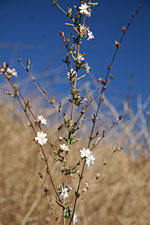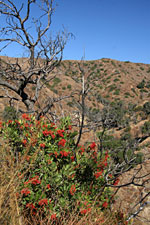Connecting with Nature
by Gabi McLean
(reprinted from The Paintbrush, January-February 2007, California Native Plant Society, San Gabriel Mountains Chapter)
|
The end of fall seems dreary Ė the long weeks without rain reflect on the plants in the wild. Many shrubs and trees lost their leaves, exposing the branches, which in turn have become brittle and dry, having changed color from a warm brown to a dirty gray. While the leaves of our local sycamores, maples, walnuts and willows change to yellow or even reddish-brown before blowing off in a Santa Ana wind, they generally just dot the landscape or frame a creek and donít provide the mass of color that people in the Eastern U.S. expect. Most grasses and other annuals have completed their seasonal cycle with their seeds and fruits already dispersed, and little evidence of their vibrant existence in spring or summer remains. Even the evergreens have a thinned canopy and the color of their leaves also reflects the lack of moisture. So why in the world would anyone go out on a hot day Ė yes there are hot days in fall - and go uphill on a south-facing slope? Well, we did so because we wanted to explore a trail we had not hiked before. We did not expect much other than dust and dirt, dry sagebrush and obnoxious grass seeds, and in the canyon crevices, a little chaparral. 
On November 19, we went up through Mystic Canyon into Little Dalton Canyon, overlooking the Walnut Creek valley to the south and with views as far as Los Angeles and Palos Verde Peninsula. It was moderately smoggy over the valley but looking north the sun shone brightly and the sky offered a deep blue. The trail quickly rose out of oak woodlands and rich riparian vegetation on a steep, sandy, hot serpentine into coastal sage scrub. We paid attention to the red, rocky outcrops, hoping for a glimpse of Dudleya multicaulis. It wasnít the right season and we didnít find any, but searching for it made the ascent more interesting. We met just a couple of hikers and felt we were all alone out there. With the sea of houses and freeways in plain sight, yet we were in the wild. And it felt good! Yes, most plants were dry but those didnít have our attention. What fascinated us were the exceptions. How gorgeous did this toyon look, generously loaded up with big clusters of those Christmas-red berries! Yellow-rumped warblers bustling in the laurel sumac. And just at what elevation were we, the laurel sumac and lemonade berry were still growing way up here, shouldnít the frost have killed them? |
And low and behold, there were flowers in November! On long, leafless branches stuck the star-like, white and lavender blossoms of the Stephanomeria. The Senecio shone brightly with its yellow, daisy-like flowers. Then we found a mountain mahogany covered with its picturesque, feathery fruits. It must have been flowering just a couple of weeks earlier, just like the bright green coyote brush. Most astonishing and exciting was the discovery of a few new branches of the chaparral currant with the most exquisite pink flowers hanging in dainty little clusters from the still leafless branches that were dotted with new leaf buds. In November? We could barely recall the few raindrops that had fallen one day in October. Did it rain more here? Will these flowers survive if it doesnít keep on raining? Our many unanswered questions did not prevent us from deeply appreciating this first sign of the coming spring. 
Itís all in our attitude, and itís the same for people and plants alike. We look for the hidden treasures, the beauty that becomes apparent with knowing and looking past the surface, expecting to find the something worthy. And then we do! But the discovery of the resurfacing of life in mid-November, ever so subtle in this sea of still resting plants, also brought to consciousness another concept. Not only does the drabness of fall make us appreciate the beauty and vibrancy of spring so much more. I also realized that we need change, we need rest, and itís ok to be relaxed, and do nothing. By honoring the cycle of rest and growth, we are able to conserve and rebuild our energies for the next season when new challenges face us, new opportunities await us, and weíll shine at our best. For me, that was a very important lesson, as I usually feel uncomfortable not doing something, constantly being driven. So connecting with nature taught me once more an important lesson. It brought to my consciousness that the open space, the trails into the wilderness and especially the wilderness itself, have immeasurable value for our mental wellbeing. If we just listen to the messages that nature and wilderness offer, weíll be OK. We can weather a storm and start anew, we give it time and try again if itís not working the first time, or a second or third time. We need to rest and accept the change, embrace the dry season, the rains and floods to come to be able to enjoy the growth and beauty that surely will follow. |
Keywords: Gabi McLean, Cliff McLean, Gabriele McLean, Clifford McLean, Nature at Hand, Gabi Horn, Gabriele Horn, Plants of the San Gabriel Mountains: Foothills and Canyon, Interpretive Guide on CD, Plants of the San Gabriel Foothills and Canyons, California native plants, Pasadena, Los Angeles, Los Angeles County, San Gabriel Valley, Southern California, Covina, natural, nature photography, photograph, environmental education, naturalist, docent, hike, hiking, CD-ROM, California native garden, gardening, flowers, wildflowers, San Gabriel Mountains, Angeles National Forest, California Native Plant Society, CNPS, Eaton Canyon Nature Center Associates, ECNCA, Mt. Baldy, Mount Baldy, Mt. San Antonio, Mount San Antonio